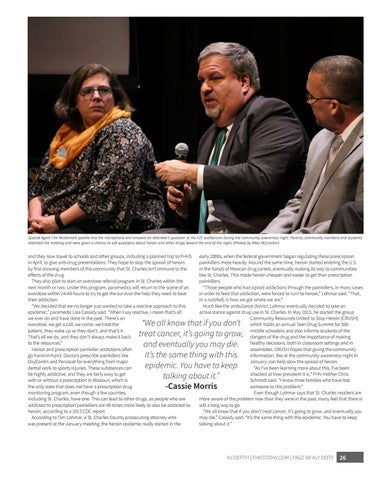Special Agent Tim McDermott speaks into the microphone and answers an attendee’s question at the FZE auditorium during the community awareness night. Parents, community members and students attended the meeting and were given a chance to ask questions about heroin and other drugs toward the end of the night. (Photos by Riley McCrackin)
and they now travel to schools and other groups, including a planned trip to FHHS in April, to give anti-drug presentations. They hope to stop the spread of heroin by first showing members of the community that St. Charles isn’t immune to the effects of the drug. They also plan to start an overdose referral program in St. Charles within the next month or two. Under this program, paramedics will return to the scene of an overdose within 24-48 hours to try to get the survivor the help they need to beat their addiction. “We decided that we no longer just wanted to take a reactive approach to this epidemic,” paramedic Lisa Cassidy said. “When I say reactive, I mean that’s all we ever do and have done in the past. There’s an overdose, we get a call, we come, we treat the patient, they wake up or they don’t, and that’s it. That’s all we do, and they don’t always make it back to the resources.” Heroin and prescription painkiller addictions often go hand-in-hand. Doctors prescribe painkillers like OxyContin and Percocet for everything from major dental work to sports injuries. These substances can be highly addictive, and they are fairly easy to get with or without a prescription in Missouri, which is the only state that does not have a prescription drug monitoring program, even though a few counties, including St. Charles, have one. This can lead to other drugs, as people who are addicted to prescription painkillers are 40 times more likely to also be addicted to heroin, according to a 2015 CDC report. According to Tim Lohmar, a St. Charles County prosecuting attorney who was present at the January meeting, the heroin epidemic really started in the
early 2000s, when the federal government began regulating these prescription painkillers more heavily. Around the same time, heroin started entering the U.S. in the hands of Mexican drug cartels, eventually making its way to communities like St. Charles. This made heroin cheaper and easier to get than prescription painkillers. “Those people who had opioid addictions through the painkillers, in many cases in order to feed that addiction, were forced to turn to heroin,” Lohmar said. “That, in a nutshell, is how we got where we are.” Much like the ambulance district, Lohmar eventually decided to take an active stance against drug use in St. Charles. In May 2015, he started the group Community Resources United to Stop Heroin (CRUSH), which holds an annual Teen Drug Summit for 350 middle schoolers and also informs students of the dangers of the drug and the importance of making healthy decisions, both in classroom settings and in assemblies. CRUSH hopes that giving the community information, like at the community awareness night in January, can help slow the spread of heroin. “As I’ve been learning more about this, I’ve been shocked at how prevalent it is,” FHN mother Chris Schmidt said. “I know three families who have lost someone to this problem.” Even though Lohmar says that St. Charles resident are more aware of the problem now than they were in the past, many feel that there is still a long way to go. “We all know that if you don’t treat cancer, it’s going to grow, and eventually you may die,” Cassidy said. “It’s the same thing with this epidemic. You have to keep talking about it.”
“We all know that if you don’t treat cancer, it’s going to grow, and eventually you may die. It’s the same thing with this epidemic. You have to keep talking about it.” -Cassie Morris
IN-DEPTH | FHNTODAY.COM | PAGE BY ALY DOTY
26
